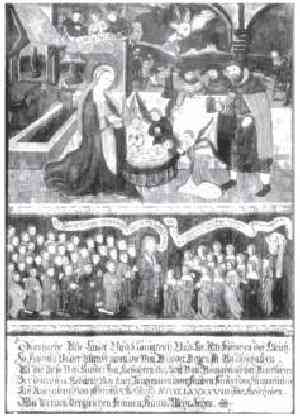
Boys' Clothes: 16th Century Country Trends

Figure 1.--This fascinating German painting depicts the children of a mother who had 53 children, few who actually survived. The painting was done between 1505 and 1509 at Bönnigheim near Heilbronn. It shows Adam Stratzmann (-1504) and his wife Barbara Schmotzerin (-1503) together with their 53 children (38 boys and 15 girls). The upper part shows a Chrismas scene, showing how the Church was still a major force in 16th century art.
|
Our coverage of 16th century trends is still very limited. We have developed some limited information in individual countries. The Renaisance which began in Italy in the 13th century had by the 15th century reached the norther countries of Western Europe. The art was, however, still strongly influenced by the Church. Depictioins of children other than scions of Italian princely fa,milies are still quite rare, especially early in the century. There was in the 16th century considerable continuity accross countries, especially with the privlidged classes. Some European countries, however, were notably different. One of these was Poland whose King King Ladislaus Vasa in the 16th century promoted traditional national styles instead of the fashions popular in Western Europe. We note a fascinating German painting depicting the children of a mother who had 53 children, few who actually survived. The painting was done between 1505 and 1509 at Bönnigheim near Heilbronn. It shows Adam Stratzmann (-1504) and his wife Barbara Schmotzerin (-1503) together with their 53 children (38 boys and 15 girls). The upper part shows a Chrismas scene, showing how the Church was still a major force in 16th century art. Of course the Christmas scene celebrates the birt of Jesus and thus apporopriate for the depictioin of this most prolific German mother. . The births took place during a period of 30-35 years, and sadly most of the children died shortly after birth, few of them reaching their 7th year. (She bore 18 single children, 5 twins, 4 tripplets, 1 sixletts and 1 sevenlets. No more than 4 children survived at each birth, 19 children died after birth, none of the remaining reached the 7th year. Note that the picture depicts the children at the same age. The inability or lack of interest in depicting people at different ages as well as problems associated wit perspective were other hallmarks of Medieval art and obviously not yet addressed in arly 16th century art, esprecially outsude Italy. Unfortunately the image is too small to tell much about the clothing, but hopefully we will eventually obtained a larger image. The Stratzmanns were a poor family, thus the painting theoretically illustartes the clothing wirn by humble people at the time (figure 1). A German reader tells us, "The boys wear robe like clothes showing colours of dark and bright brown, black and red. As for trouseres they seem to wear a kind of thights in bright to dark brown and red. The girls wear dark to bright brown, black and red dresses with a white collar and a black- bright brown bonnet."
HBC

Navigate the Historic Boys' Clothing Web Site:
[Introduction]
[Activities]
[Biographies]
[Chronology]
[Clothing styles]
[Countries]
[Bibliographies]
[Contributions]
[Essays]
[FAQs]
[Glossaries]
[Satellites]
[Tools]
[Boys' Clothing Home]
Navigate the Historic Boys' Clothing Web chronological pages:
[Return to the Main chronology page]
[The medieval era]
[The 15th century]
[The 16th Century]
[The 17th century]
[Early 18th century]
[Mid-18th century]
[Late-18th century]
[The 19th century]
Created: August 27, 2003
Last updated: August 28, 2003



